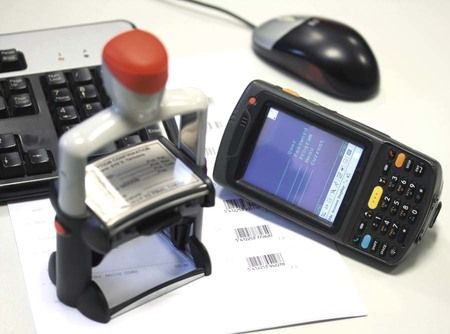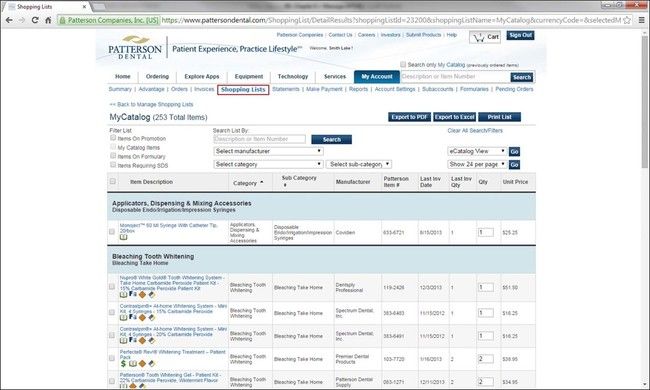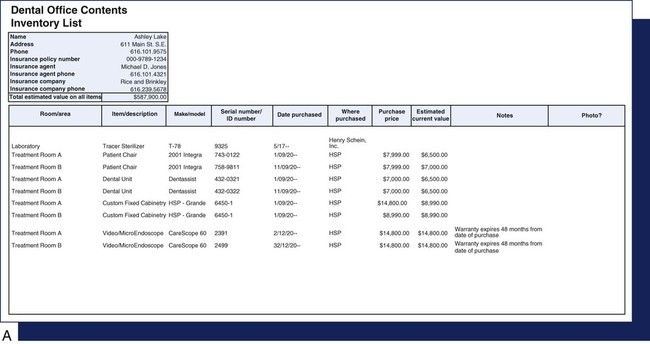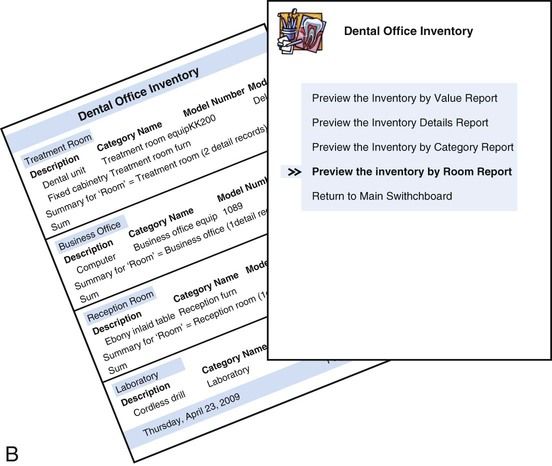Practice Note
Whether at chairside, in the laboratory, or in the business office, dental professionals find it frustrating to reach for an item and find only an empty box.
Types of Supplies
Basic Categories
Supplies can be divided into three basic categories: expendable supplies, nonexpendable supplies, and capital supplies. Expendable supplies are single-use items such as dental cements, stationery, local anesthetics, and gypsum products. Nonexpendable supplies are reusable items that do not constitute a major expense; this category includes most dental instruments. Capital supplies are large, costly items that are seldom replaced, such as computers, sterilizers, and dental units.
Selecting Supplies
Not all materials can be purchased from one supplier, and buying from several suppliers may be more economical. Shopping locally promotes good relations and stimulates the local economy, but for economic reasons a dentist may order supplies from a larger catalog or a discount house.
A dental supply house can provide all of the basic dental supplies, both brand name and generic. Purchasing from the dealers in a local area is convenient, but many large wholesale supply houses provide quick service and special rates. Making use of toll-free telephone numbers or ordering online can also speed up service. Make sure that the vendor is reliable; the materials must be quality products, and, where applicable, they must meet American Dental Association specifications.
Many dealers routinely send representatives to dental offices to obtain orders. The administrative assistant should have the order prepared or information available about what is needed in one of the inventory management systems. A manufacturer’s representative who wants to see the dentist about a new product may accompany the supply person. If the dentist’s schedule does not allow time to meet with the representative, information about the new products can be obtained and relayed to the dentist later.
Medicaments, which are not specifically dental items, can be purchased from a local pharmacy. Surgical supply companies sell materials such as thermometers, surgical scissors, and hemostats.
Business materials are available from local business office supply stores or online. Some supplies, such as cleaning materials, must be purchased at local businesses or specialty companies.
For convenience, a file of the business addresses and telephone numbers of all of the companies patronized routinely can be kept on the computer (see Chapter 8).
Designing an Inventory System
The first step in inventory control organization is to streamline inventory management. An inventory system is a list of the stock and assets in the dental office. This list is divided into two parts: capital equipment and expendable and nonexpendable supplies. Become familiar with the types and quantities of products and materials used in the office. In addition, become quickly familiar with the monetary value of the current inventory and what the minimum and maximum quantities of the products are for the office. With a manual system, this can be done using a spreadsheet, as will be discussed later in this chapter. With a computer system, a formulary can be set up to identify all of the products commonly used in the office. This is done primarily for the expendable and nonexpendable products. However, some systems provide a component in the software for capital equipment to be listed as well.
Capital Equipment Inventory Control
A spreadsheet can be used to maintain an inventory of capital equipment. For a spreadsheet, software such as Excel or Access can be used. The administrative assistant can track all of the major categories of capital supplies and have vital purchase and warranty information at his or her fingertips. Figure 13-1, A, illustrates the headings on a spreadsheet for each capital item and details important information about the item, including date of purchase, serial numbers, and any comments about the product, including warranty dates. The system shown in Access in Figure 13-1, B, allows for the development of a cardlike system within the software for each room or category desired. In both Excel and Access software, templates are available that can be adapted for the individual needs of a specific office. A spreadsheet system can save much time and guesswork regarding the servicing of equipment, and it can be helpful to the accountant for determining depreciation. This information should be reviewed frequently for necessary preventive maintenance service. Such service is best scheduled when the dentist is out of the office.
Expendable and Nonexpendable Supplies Inventory Control
Dental offices generally do not keep a large stock of nonexpendable supplies on hand; however, a list may be included in an inventory system if the dentist wishes. Because the expendable supplies require more attention, an inventory of these items is important. The inventory can be automated on a computer through the formulary or maintained manually.
Automated Inventory Systems
Most dental supply dealers provide inventory management systems for their customers. The type of system may vary, but one manual system involves products being placed in bins or containers with tags that identify the product, the quantity to order, and the reorder point for the product. When a product needs to be reordered, the tag is removed from the container and placed in a location, where the order can then be created from the various tags. Other dealers provide systems that reference bar codes on products so that, when a product is used, the bar code (Figure 13-2) is scanned and the data goes directly to the supply house through the database that is linked to the office.

Many systems like this are Internet based, and the company will provide bar coding or other techniques that staff members can use when taking items out of inventory. When the reorder point is reached, the product information is scanned with the reader (see Figure 13-2) and stored until it can be uploaded from the office computer, via the Internet, to the appropriate dealer site. Many programs will give a cost comparison for purchasing products from the company and can complete an order with just a few extra steps.
When all products have been entered into the system, a total value of the inventory can be provided; this is helpful for tax returns, financial management, and budgeting. The system can also track money spent for supplies by category on an ongoing basis. Some systems provide reports in a list or in a graph or chart format, which is helpful for making monthly or yearly comparisons. When analyzed, these comparisons can provide valuable data for the practice in terms of the amount of money invested in certain types of products and supplies; they can also help to identify where changes might be necessary to increase profitability.
An office that uses an automated system will find that it is relatively easy to place orders and that the staff can be assured that products will always be available. Consider the following example:
The dentist makes an agreement with the supply house and is logged into the supply house’s system. An account is established, and a formulary (i.e., a list of approved and preferred items) is created. The administrative assistant or another staff member can then log into My Account with a username and password (Figure 13-3). From the screen, the user selects My Account, which then enables the person to choose from a list of categories. These may include the following:


Stay updated, free dental videos. Join our Telegram channel

VIDEdental - Online dental courses


 Practice Note
Practice Note

